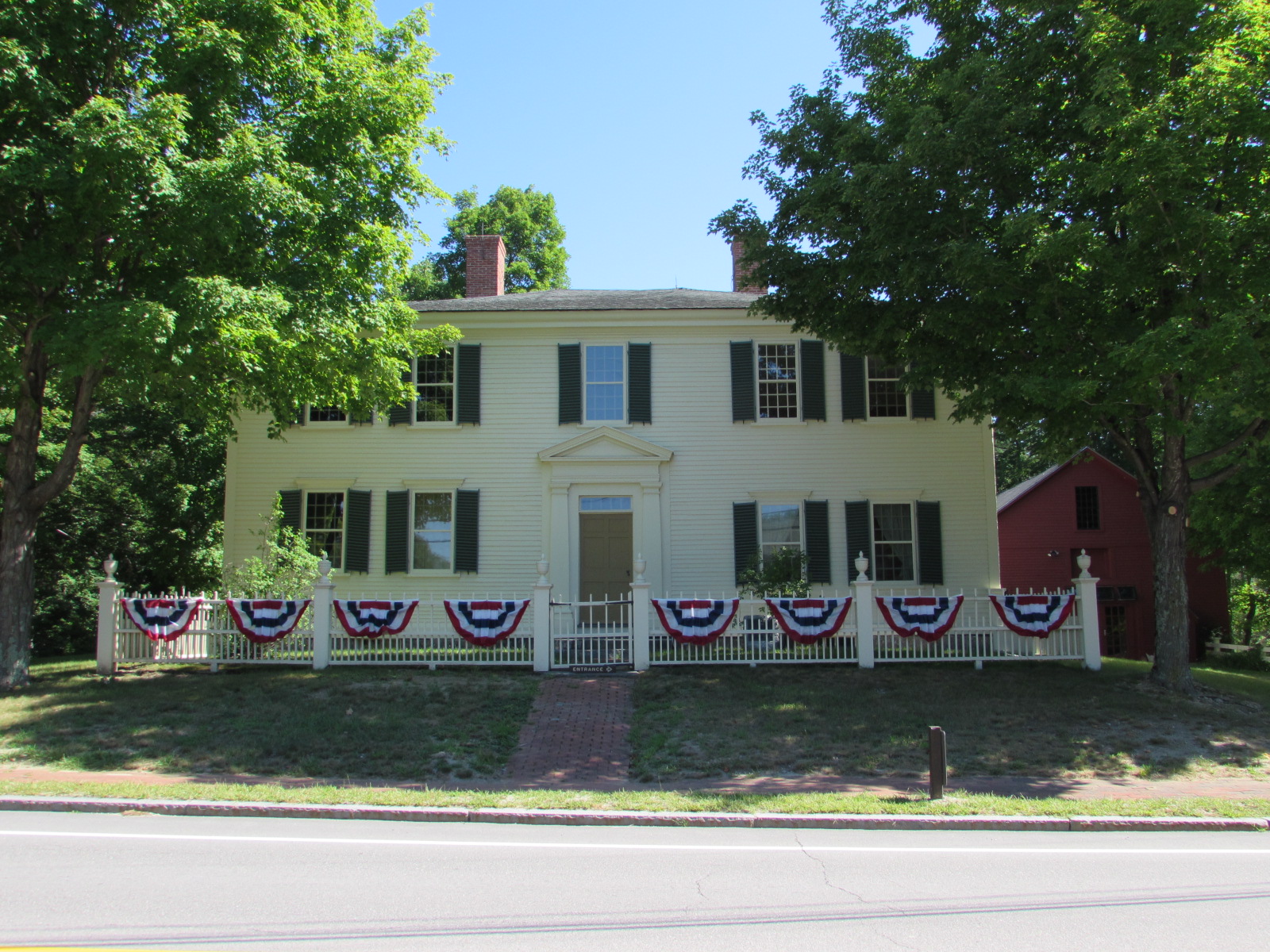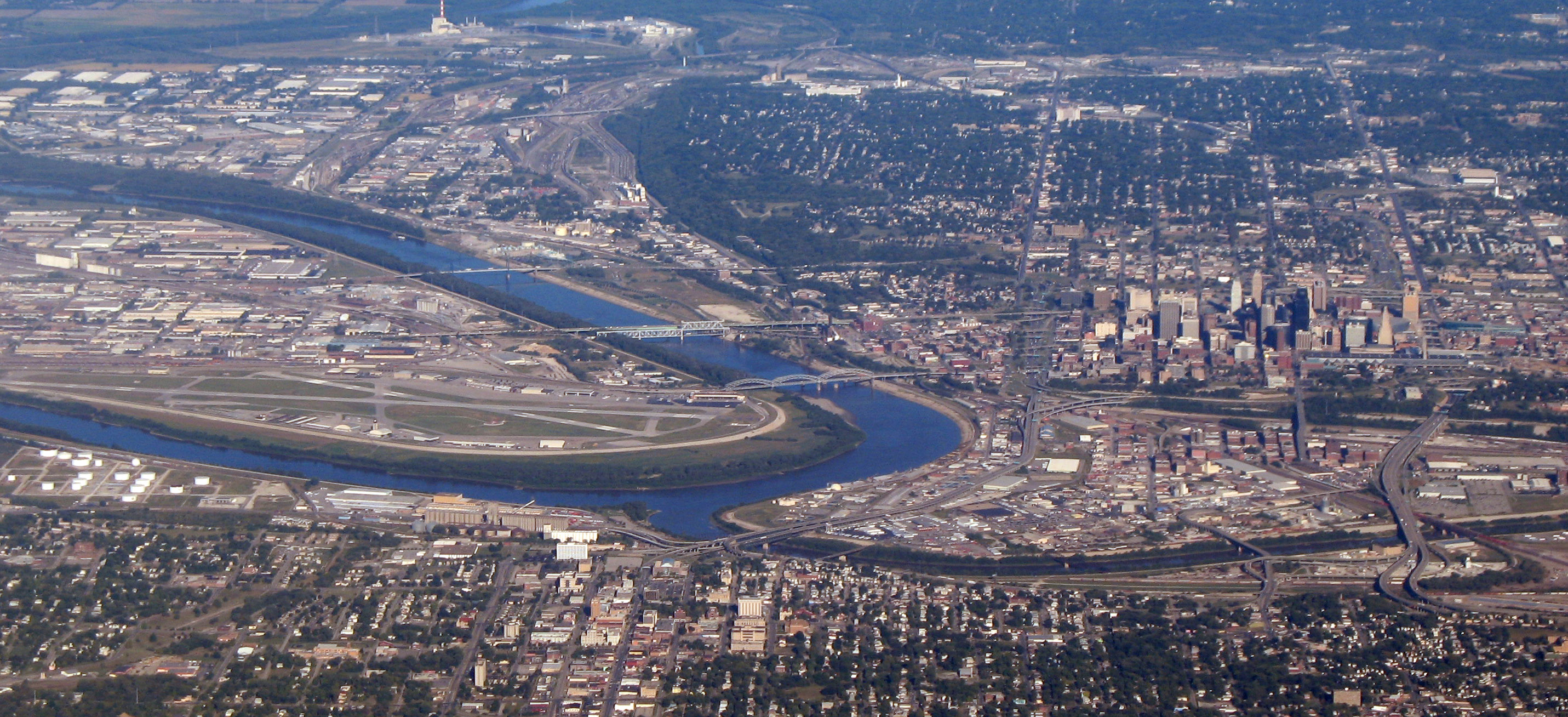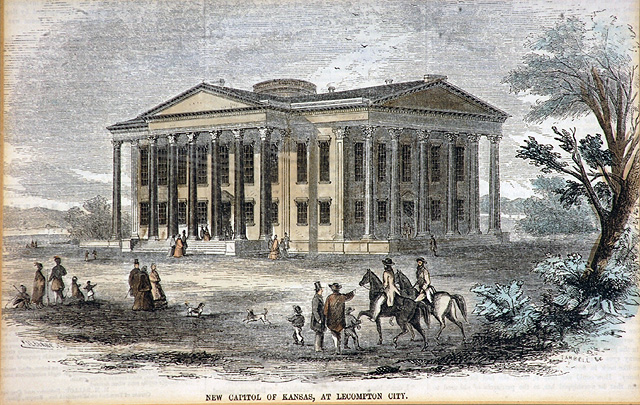|
Constitutions Of Kansas
Under U.S. law, a state requires a constitution. A main order of business for Territorial Kansas was the creation of a constitution, under which Kansas would become a state. Whether it would be a slave state or a free state, allowing or prohibiting slavery, was a national issue, because it would affect voting in the polarized U.S. Senate. Because of tensions over slavery, four quite different constitutions of Kansas were drafted. Topeka Constitution Text of the Topeka Constitution The Topeka Constitutional Convention met in opposition to the first territorial legislature, from which free-staters had been excluded, and that they called "bogus". It adopted the Topeka Constitution on December 15, 1855, which was approved territory-wide on January 15, 1856. Under this constitution, free Blacks were excluded from Kansas; the "Black exclusion" was voted on separately, but it passed. The constitution was sent to Congress and approved by the House on July 2, 1856, but, opposed by Pres ... [...More Info...] [...Related Items...] OR: [Wikipedia] [Google] [Baidu] |
Kansas Territory
The Territory of Kansas was an organized incorporated territory of the United States that existed from May 30, 1854, until January 29, 1861, when the eastern portion of the territory was admitted to the Union as the free state of Kansas. The territory extended from the Missouri border west to the summit of the Rocky Mountains and from the 37th parallel north to the 40th parallel north. Originally part of Missouri Territory, it was unorganized from 1821 to 1854. Much of the eastern region of what is now the State of Colorado was part of Kansas Territory. The Territory of Colorado was created to govern this western region of the former Kansas Territory on February 28, 1861. The question of whether Kansas was to be a free or a slave state was, according to the Compromise of 1850 and the Kansas–Nebraska Act, to be decided by popular sovereignty, that is, by vote of the Kansans. The question of who were the Kansans who were eligible to vote ended up causing armed conflic ... [...More Info...] [...Related Items...] OR: [Wikipedia] [Google] [Baidu] |
Slave States And Free States
In the United States before 1865, a slave state was a state in which slavery and the internal or domestic slave trade were legal, while a free state was one in which they were not. Between 1812 and 1850, it was considered by the slave states to be politically imperative that the number of free states not exceed the number of slave states, so new states were admitted in slave–free pairs. There were, nonetheless, some slaves in most free states up to the 1840 census, and the Fugitive Slave Act of 1850 specifically stated that a slave did not become free by entering a free state. Although Native Americans had small-scale slavery, slavery in what would become the United States was established as part of European colonization. By the 18th century, slavery was legal throughout the Thirteen Colonies, after which rebel colonies started to abolish the practice. Pennsylvania abolished slavery in 1780, and about half the states abolished slavery by the end of the Revolutionary War or ... [...More Info...] [...Related Items...] OR: [Wikipedia] [Google] [Baidu] |
Slavery In The United States
The legal institution of human chattel slavery, comprising the enslavement primarily of Africans and African Americans, was prevalent in the United States of America from its founding in 1776 until 1865, predominantly in the South. Slavery was established throughout European colonization in the Americas. From 1526, during early colonial days, it was practiced in what became Britain's colonies, including the Thirteen Colonies that formed the United States. Under the law, an enslaved person was treated as property that could be bought, sold, or given away. Slavery lasted in about half of U.S. states until abolition. In the decades after the end of Reconstruction, many of slavery's economic and social functions were continued through segregation, sharecropping, and convict leasing. By the time of the American Revolution (1775–1783), the status of enslaved people had been institutionalized as a racial caste associated with African ancestry. During and immediately ... [...More Info...] [...Related Items...] OR: [Wikipedia] [Google] [Baidu] |
Topeka Constitution
The Topeka Constitutional Convention met from October 23 to November 11, 1855 in Topeka, Kansas Territory, in a building afterwards called Constitution Hall. It drafted the Topeka Constitution, which banned slavery in Kansas, though it would also have prevented free Blacks from living in Kansas. The convention was organized by Free-Staters to counter the pro-slavery Territorial Legislature elected March 5, 1855, in polling tainted significantly by electoral fraud and the intimidation of Free State voters. The Topeka Constitution marked the first effort to form a Kansas governmental structure and define its basis in law. Free-State delegates passed the constitution on December 15, 1855. The -wide election for officers and approval of the constitution on January 15, 1856, was boycotted by most pro-slavery men. Among those elected was Charles L. Robinson as governor. The constitution was forwarded to Washington with a plea to the U.S. Congress for admitting Kansas as a free state ... [...More Info...] [...Related Items...] OR: [Wikipedia] [Google] [Baidu] |
President Pierce
Franklin Pierce (November 23, 1804October 8, 1869) was the 14th president of the United States, serving from 1853 to 1857. He was a northern Democrat who believed that the abolitionist movement was a fundamental threat to the nation's unity. He alienated anti-slavery groups by signing the Kansas–Nebraska Act and enforcing the Fugitive Slave Act. Conflict between North and South continued after Pierce's presidency, and, after Abraham Lincoln was elected president in 1860, Southern states seceded, resulting in the American Civil War. Pierce was born in New Hampshire. He served in the U.S. House of Representatives from 1833 until his election to the Senate, where he served from 1837 until his resignation in 1842. His private law practice was a success, and he was appointed New Hampshire's U.S. Attorney in 1845. He took part in the Mexican–American War as a brigadier general in the Army. Democrats saw him as a compromise candidate uniting Northern and Southern interests, ... [...More Info...] [...Related Items...] OR: [Wikipedia] [Google] [Baidu] |
Lecompton, Kansas
Lecompton (pronounced ) is a city in Douglas County, Kansas, United States. As of the 2020 census, the population of the city was 588. Lecompton was the ''de jure'' territorial capital of Kansas from 1855 to 1861, and the Douglas County seat from 1855 to 1858. Anti-slavery Lawrence became the ''de facto'' capital during the latter part of this period, when the county seat was moved there. This time period was known as Bleeding Kansas, due to the violence perpetrated by the pro-slavery, and to a lesser extent the anti-slavery, factions in the eastern part of the state. Lecompton was a hotbed of pro-slavery sentiment during the mid-1800s. History 19th century Lecompton was founded in 1854, on a bluff on the south bank of the Kansas River. It was originally called "Bald Eagle", but the name was changed to Lecompton in honor of Samuel Lecompte, the chief justice of the territorial Supreme Court. In August 1855, the city became the capital of the Kansas Territory after Presiden ... [...More Info...] [...Related Items...] OR: [Wikipedia] [Google] [Baidu] |
LeCompton Constitution
The Lecompton Constitution (1859) was the second of four proposed constitutions for the state of Kansas. Named for the city of Lecompton where it was drafted, it was strongly pro-slavery. It never went into effect. History Purpose The Lecompton Constitution was drafted by pro-slavery advocates and included provisions to protect slaveholding in the state and to exclude free people of color from its bill of rights. Slavery was the subject of Article 7, which protected the right to slave "property", and prevented the legislature from emancipating slaves without their owners' consent, and without full compensation to their owners. It was initially approved in a rigged election in December 1857, but overwhelmingly defeated in a second vote in January 1858 by a majority of voters in the Kansas Territory. The rejection of the Lecompton Constitution, and the subsequent admittance of Kansas to the Union as a free state, highlighted the irregular and fraudulent voting practices that had m ... [...More Info...] [...Related Items...] OR: [Wikipedia] [Google] [Baidu] |
Minneola, Kansas
Minneola is a city in Clark County, Kansas, United States. As of the 2020 census, the population of the city was 738. History Minneola was founded in 1887. Its name is a combination of that of Minnie Davis and Ola Watson, the wives of pioneer settlers. A post office first established in 1885 in Appleton (an extinct town) was moved to Minneola in 1888. Geography Minneola is located at (37.441260, -100.014406). According to the United States Census Bureau, the city has a total area of , all land. The city is roughly five blocks by eight blocks in size; everything is within walking or biking distance. Climate According to the Köppen Climate Classification system, Minneola has a semi-arid climate, abbreviated "BSk" on climate maps. Demographics 2010 census As of the census of 2010, there were 745 people, 289 households, and 194 families residing in the city. The population density was . There were 334 housing units at an average density of . The racial makeup of the city ... [...More Info...] [...Related Items...] OR: [Wikipedia] [Google] [Baidu] |
Leavenworth, Kansas
Leavenworth () is the county seat and largest city of Leavenworth County, Kansas, United States and is part of the Kansas City metropolitan area. As of the 2020 census, the population of the city was 37,351. It is located on the west bank of the Missouri River. The site of Fort Leavenworth, built in 1827, the city became known in American history for its role as a key supply base in the settlement of the American West. During the American Civil War, many volunteers joined the Union Army from Leavenworth. The city has been notable as the location of several prisons, particularly the United States Disciplinary Barracks and United States Penitentiary, Leavenworth. History Leavenworth, founded in 1854, was the first city incorporated in the territory of Kansas. The city developed south of Fort Leavenworth, which was established as Cantonment Leavenworth in 1827 by Colonel Henry Leavenworth. Its location on the Missouri River attracted refugee African-American slaves in the a ... [...More Info...] [...Related Items...] OR: [Wikipedia] [Google] [Baidu] |
Kansas City, Kansas
Kansas City, abbreviated as "KCK", is the third-largest city in the U.S. state of Kansas, and the county seat of Wyandotte County. It is an inner suburb of the older and more populous Kansas City, Missouri, after which it is named. As of the 2020 census, the population of the city was 156,607, making it one of four principal cities in the Kansas City metropolitan area. It is situated at Kaw Point, the junction of the Missouri and Kansas rivers. It is part of a consolidated city-county government known as the "Unified Government". It is the location of the University of Kansas Medical Center and Kansas City Kansas Community College. History In October 1872, "old" Kansas City, Kansas, was incorporated. The first city election was held on October 22 of that year, by order of Judge Hiram Stevens of the Tenth Judicial District, and resulted in the election of Mayor James Boyle. The mayors of the city after its organization were James Boyle, C. A. Eidemiller, A. S. Orbison, ... [...More Info...] [...Related Items...] OR: [Wikipedia] [Google] [Baidu] |
Bleeding Kansas
Bleeding Kansas, Bloody Kansas, or the Border War was a series of violent civil confrontations in Kansas Territory, and to a lesser extent in western Missouri, between 1854 and 1859. It emerged from a political and ideological debate over the legality of slavery in the proposed state of Kansas. The conflict was characterized by years of electoral fraud, raids, assaults, and murders carried out in the Kansas Territory and neighboring Missouri by proslavery " border ruffians" and antislavery " free-staters". According to ''Kansapedia'' of the Kansas Historical Society, 56 political killings were documented during the period, and the total may be as high as 200. It has been called a Tragic Prelude, or an overture, to the American Civil War, which immediately followed it. The conflict centered on the question of whether Kansas, upon gaining statehood, would join the Union as a slave state or a free state. The question was of national importance because Kansas's two new senators ... [...More Info...] [...Related Items...] OR: [Wikipedia] [Google] [Baidu] |
Constitution Hall (Lecompton, Kansas)
Lecompton Constitution Hall, also known as Constitution Hall, is a building in Lecompton, Kansas, that played an important role in the long-running Bleeding Kansas crisis over slavery in Kansas. It is operated by the Kansas Historical Society as Constitution Hall State Historic Site. History Constitution Hall was constructed by Samuel J. Jones, the pro-slavery sheriff tasked with keeping the peace in Douglas County in the 1850s. He rented the structure out to the territorial government based out of Lecompton. During 1857 this building was one of the busiest and most important in Kansas Territory. Thousands of settlers and speculators filed claims in the United States land office on the first floor. They sometimes fought hand-to-hand for their share of the rich lands that were opening for settlement. The government was removing the Native Americans from Kansas to make their lands available to whites. Upstairs the district court periodically met to try to enforce the territoria ... [...More Info...] [...Related Items...] OR: [Wikipedia] [Google] [Baidu] |






.jpg)


